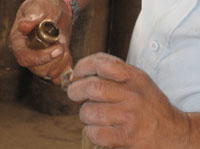 |
Most solvents are liquid organic chemicals and are toxic in nature but the degree of hazard varies from one substance to another. At the workplace the intake of chemicals occurs mainly through inhalation and skin contact. Another major risk on the shop floor level is flammability. While these hazards affect directly and immediately the workplace the environmental hazards like contamination of air, soil and ground water are rather indirect and effects not only at the workplace but also on a global scale. Detailed information on hazard classification of solvents is available here.
|
EXPOSURE ROUTES
• Inhalation (breathing in)
Most solvents may be dispersed into the air to form mist, gas or vapour and hence the workers and even those who are not actually handling the solvents will also get exposed to them.
• Absorption (through the skin or eyes)
Most chemicals are readily absorbed through the skin. Frequent skin contact can de-fat the protective layer of the skin and can enter in to the blood stream. Some solvent vapours may be absorbed through the skin without any noticeable change to the skin.
• Ingestion (eating, drinking)
Solvents can enter the body through ingestion as vapours, fumes or liquids. Unhygienic practices like keeping food, cigarette, etc near the workplace and consuming them with soiled hands will lead to ingestion of solvents.
Prevention and Control Measures
Good occupational hygiene promotes elimination of hazards. A number of control measures like engineering controls, administrative controls, etc exist. Industries should implement these following measures to ensure health and safety of workers and to protect the environment.
Administrative Controls
Good house keeping, optimum usage of solvents and substitution with less hazardous chemicals can reduce the exposure levels considerable.
Substitution
The very need to use a solvent should be avoided wherever possible by selecting an alternative process; if this is not possible then a hazardous solvent can be replaced with a less hazardous one.
Substitution is not a hit and miss method but a complex process that requires research and experimentation. Substitution is the most powerful and desirable control method.
Engineering controls
If Safety level achieved by substitution is not adequate enough to reduce the hazard to acceptable levels, then engineering controls should be used to minimize the hazard at the source.
Ventilation
Good ventilation ensures that fumes are drawn away from the point of origin and away from the operator. It is recommended to perform cleaning operations in well ventilated area using optimum quantity of solvent.
Local exhaust ventilation
Properly designed local exhaust ventilation is the next choice to remove the contaminants at the source. A local exhaust ventilation system consists of a hood, ducts or pipes, a system to collect and separate the pollutants from the clean air, and an efficient fan to create enough suction force.
Personal Protective Equipment
Personal protective devices should be regarded as being supplementary to substitution and engineering control and should not be used in preference to the latter because they do nothing to eliminate the hazard.
Personal protective equipment must be appropriately selected, individually fitted and workers trained in their correct use and maintenance. Personal protective equipment must be regularly checked and maintained to ensure that the worker is being protected.
Different types of Personal Protective equipment are Masks, Goggles, Face Shields, Gloves, Full body work clothing, Respirators etc.
Flammability: Most solvents are highly flammable and must be used with due precautions to minimize fire risk. The work premises should be equipped with fire detectors, alarm systems and appropriate fire extinguishers.
Environment: Some solvents are hazardous to the environment and are toxic to aquatic organisms and may cause long-term adverse effects in the aquatic environment hence care must be taken for safe disposal of used solvents and solvent soaked wastes.
n most cases, CTC is used to remove unwanted deposits. Materials cleaned range from metal, glass and rubber to delicate materials ssuch as fabric and photographic films.
Contaminants to be removed are equally varied and include grease, oils, dust, carbon, inks and gums.
New
publication
"Dissemsination of the Environment, Health and
Safety manual for National CTC Phase-out Program".
Published by Sri Ramachandra
University in association with GTZ Proklima.
To download the manual please click
here

